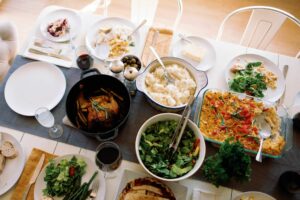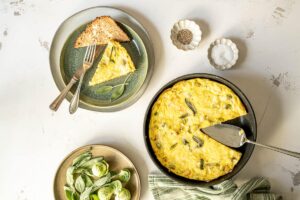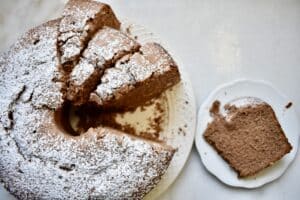Let’s Hear it for Pancakes!
Whenever I think of the month of May, (after I think “hey, it’s spring!”), I think of moms, because Mother’s Day is celebrated in May. Even though Mother’s Day has passed, I thought it would be nice to pay tribute to moms…for all they do, have done, and will do for us. I hope everyone has a favorite memory of mom (or grandma, or someone!) making pancakes on the weekend. I surely do! To all the moms who are working with different dietary constraints for their children, this one’s for you!
In this article, I offer pancake recipes, all delicious, all addressing different issues—gluten-free, grain-free, GAPS. I will tell you how to make them, and why to make them. Here’s to pancakes in your home again!
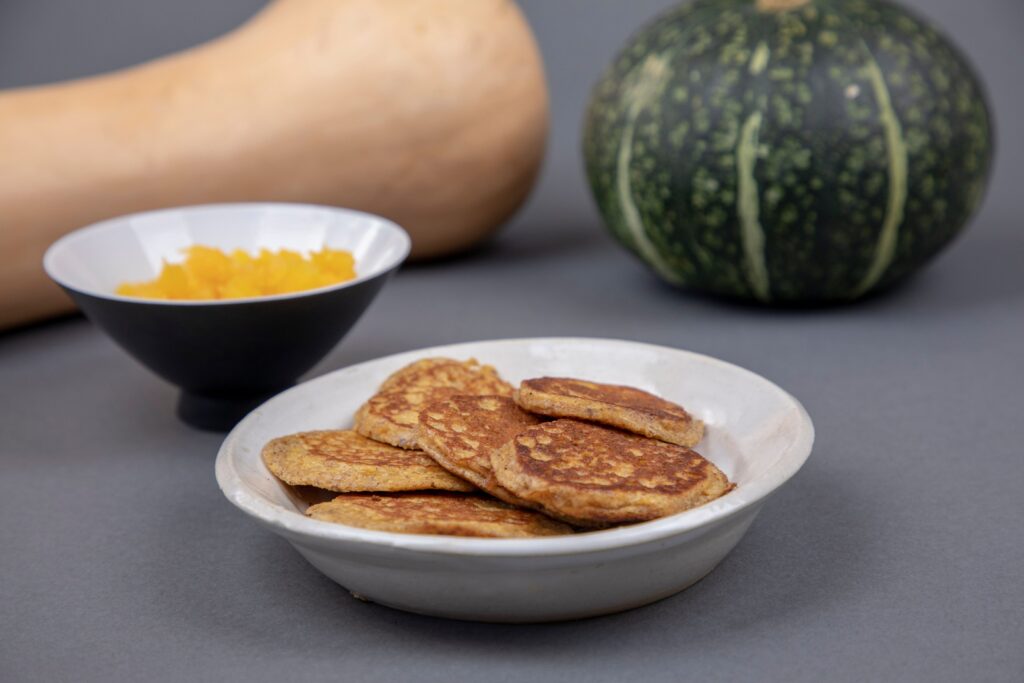
Getting a Pan, Skillet, or Griddle to Temperature
No need for a “non-stick” pan, which can expose your family to all sorts of toxins we would rather not serve to them! All pans will be non-stick if you get them to the correct temperature prior to adding ingredients. I prefer a cast-iron skillet and own several sizes for all my cooking needs. If you follow these easy instructions, your pan will be “non-stick” also!
Heat a medium or large skillet to medium heat. Add fat and melt. To test to see if the skillet is ready, dampen your hand with a bit of water. Keeping your hand far enough above the pan so there is no possibility of the water burning you, flick a few very small drops of water in the pan. If it sizzles, it is ready. If it does not sizzle, it is not ready, wait another minute or two and try again.
Toppings!
Serve your pancakes with more pastured butter and maple syrup or berries and whipped cream! Remember that adding a good, healthy fat like pastured butter will help your body handle any sugar you eat.
Note for GAPS: maple syrup is not allowed, so substitute raw honey or pureed berry syrup. Replace whipped cream with cultured cream-aka crème fraiche.
Pancakes made with Nuts or Seeds
Nuts and seeds provide a high protein alternative to pancakes made with flour. They are also “low carb”, so they will not initiate a blood sugar spike (unless you cover them with syrup, so go easy on it!). The recipes use almonds (because they are readily available, and have a neutral flavor), but feel free to swap them out with other nuts or seeds if you like. Sunflower seeds and pumpkin seeds are also somewhat “neutral” in flavor. See which ones your family likes best!
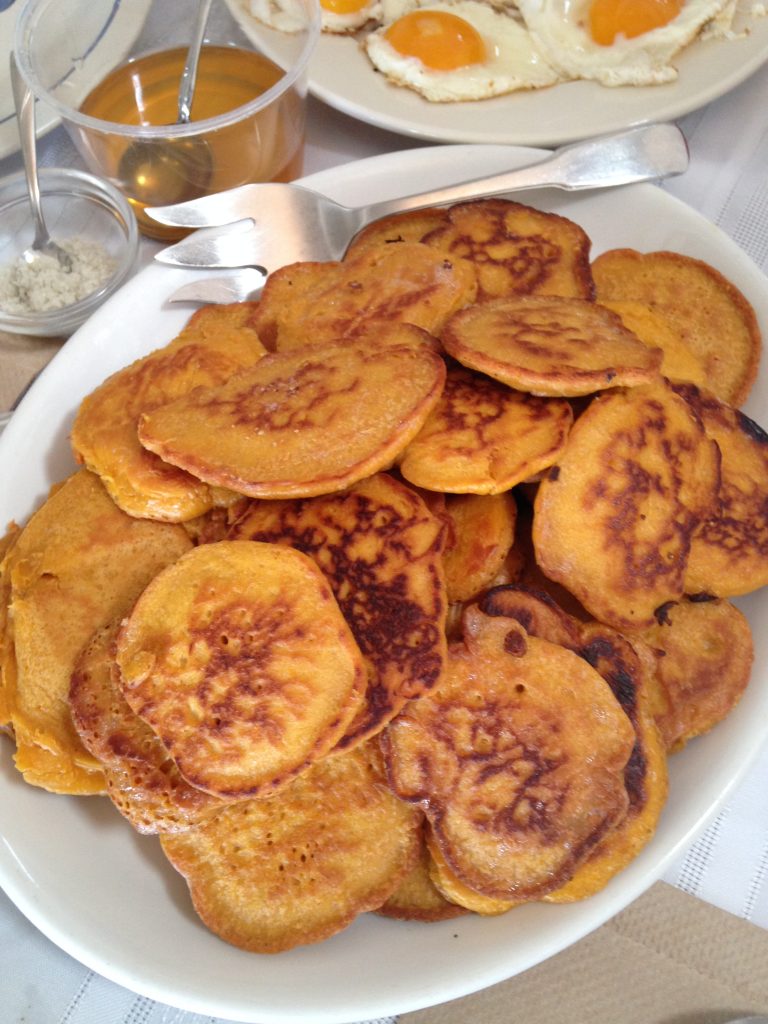
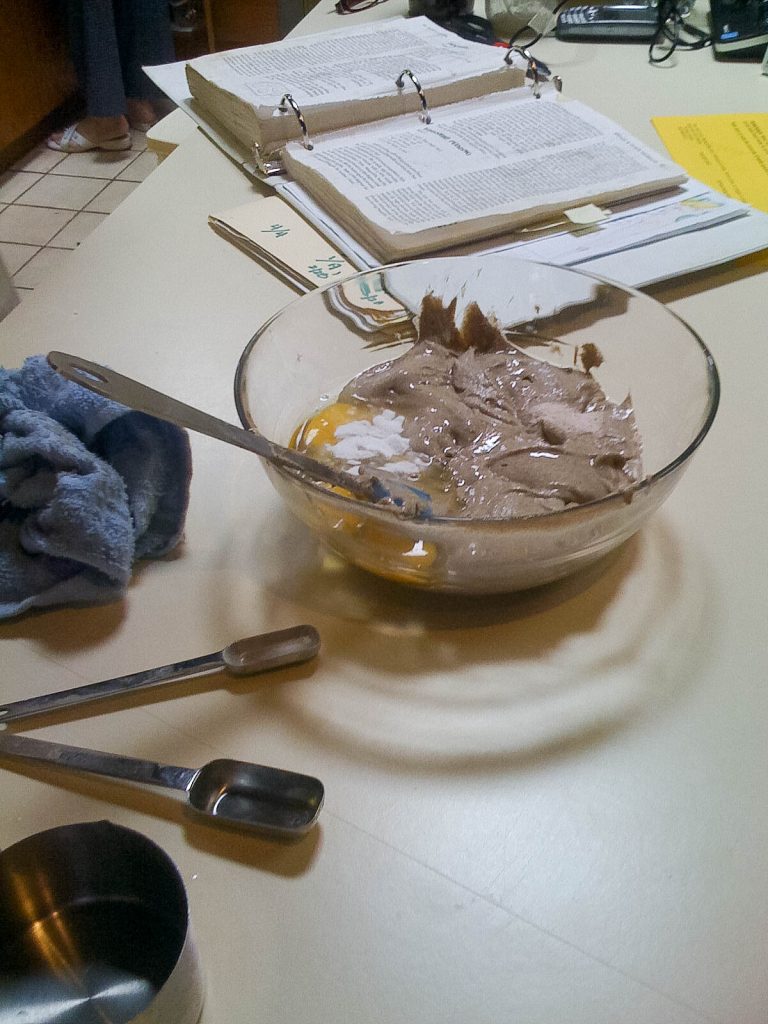
Nut/Seed Flour Pancakes: Gluten-Free, Grain-Free, GAPS
Ingredients:
- 4 eggs, pastured and organic best
- 1⁄2 cup raw milk (or coconut or almond milk. For GAPS, mix some yogurt with a bit of pure water to get 1⁄2 cup. As always, homemade is best if possible.)
- 1 1⁄2 cups almond flour (or other nut/seed flour)
1⁄2 teaspoon Celtic or sea salt, no anti-caking agents 1⁄2 – 1 teaspoon baking soda if desired for more rise - 2 tablespoons or more of pastured butter, ghee or coconut oil (or a combination) for the pan
Instructions:
- Place eggs and milk into a blender and blend for one minute.
- Add dry ingredients and blend.
- When the pan is ready, add the butter or fat to the pan.
- Spoon the batter into the pan using a tablespoon or small ladle.
- Pancakes are ready to flip after bubbles form and burst on the top of the cake.
This batch will feed two adults for breakfast. Double the recipe if you would like leftovers.
Nut Butter Pancakes: Gluten-free, Grain-free, GAPS
For these pancakes, you may use nut butter or seed butter. The “cadillac” in terms of ease of digestion and nutrient availability? Your homemade nut or seed butter—made from soaked, sprouted, or fermented nuts. (To learn about how to work with nuts and seeds, see my The Complete Cooking Techniques for the GAPS Diet.) All nuts and seeds are chock full of anti-nutrients that can rob minerals from your body and inhibit digestion, so traditional preparation techniques are critical if you eat nuts and seeds often and depend upon them for protein. If you don’t want to make your own or don’t have the time to do so, the next best is organic, sprouted nut or seed butter. There are several brands available for purchase now. You may also wish to try coconut manna in place of nut or seed butter.
Ingredients:
- 2 tablespoons nut or seed butter, or coconut manna
- 3-4 eggs, pastured and organic best
- 1-2 cups baked and mashed winter squash, optional (note: butternut squash is Full GAPS)
- 1⁄2 teaspoon Celtic or sea salt, no anti-caking agents
- 1⁄2 teaspoon baking soda, if desired
- 2 tablespoons or more of pastured butter, ghee or coconut oil (or a combination) for the pan
Instructions:
- Blend all ingredients together in a blender or food processor until smooth.
- Heat a medium or large pan or skillet over medium heat. (See instructions above.) Add butter or other fat and melt.
- Spoon in the batter and flip when bubbles on the surface burst.
The number of pancakes the recipe yields will depend upon if you use the squash or not, as well as how much you use. With squash, more than 2 adults. Without squash, just about two adults. Double the recipe if you would like leftovers.
Pancakes made with Grains
Soaked/Fermented Flour
Soaking flour in cultured dairy for 12-24 hours (or more) will help to pre-digest the grain before you eat it. Though pancakes made with grain will still be high in carbohydrate, soaking will mean less of a blood- sugar spike because you have soaked the prior to cooking. You may soak gluten-free or gluten-full grains; the longer you soak, the better for your digestion.
Gluten-free grains are buckwheat, oat, rice, amaranth, quinoa, corn, teff. (Note that some mills process both gluten and gluten-free grains, so gluten-free grains can be contaminated by gluten. Check the label.)
Gluten-full grains are wheat, spelt, triticale, khorasan, emmer, einkorn, kamut, barley, rye, etc. Please note that if you are going to eat wheat in the US, you will want to purchase organic wheat flour. Conventional wheat flour is full of glyphosate, a chemical that has been connected with leaky gut (increased intestinal permeability) and all the problems associated with it (allergies, auto-immune disorders, autism, ADD/ADHD, and many more. For more information about healing leaky gut, see Dr. Natasha Campbell-McBride’s Gut and Psychology Syndrome. For more information about glyphosate, start with Stephanie Seneff, PhD and Zach Bush, MD.)
It is also highly recommended that even if you do not “have a problem with wheat or gluten”, eat instead traditional, ancient wheat such as einkorn, emmer, spelt, or khorasan. These grains have not been hybridized over the years to increase their gluten content as has American wheat, and are more nutritious to boot!
You may soak with yogurt, milk kefir, cultured cream, raw milk (never pasteurized milk), or a combination of them. Using homemade raw cultured dairy is always best, whether cow, goat, milk or sheep. (Learn more about the benefits of raw dairy here: https://www.realmilk.com/. Learn how to make your own yogurt in one of my previous blogs on Plan to Eat or in my book, The Complete Cooking Techniques for the GAPS Diet, in the section on Culturing Dairy.) If you do not have access to fresh, raw milk, be sure to purchase organic, whole milk, plain cultured dairy products with no fillers. If they are from pastured cows, (grass-fed), all the better!
Soaked Spelt, Einkorn, or Emmer Pancakes: Nut-Free, WAPF
Ingredients:
- 2 cups yogurt, milk kefir, cultured cream, raw milk, (or a combination. Using raw milk solo will yield thinner pancakes.)
- 2 cups organic flour: spelt, einkorn, emmer (or a combination. If you can grind it yourself, even better!)
- 3 eggs, pastured and organic is best
- 1⁄2 teaspoon Celtic or sea salt, no anti-caking agents
- 1 teaspoon baking soda, optional
- 2 tablespoons or more of pastured butter, ghee or coconut oil (or a combination) for the pan
Instructions:
The day before (24 hours) or the night before (12 hours) breakfast. (The longer you soak, the better! You can soak for 48-72 hours prior to cooking!):
In a large bowl, mix the flour with the cultured dairy of your choice. Cover the bowl with a plate or a towel and leave on the counter at room temperature (68-72° F/20-22°C) until you are ready to cook them.
When you are ready to cook:
- Whisk the eggs in a small bowl. Add to the soaked flour and mix well.
- Add the salt and baking soda, if desired. Mix well.
- Heat a medium or large skillet to medium heat (see instructions above). Add fat and melt.
- When the pan is ready, spoon the batter into the pan using a tablespoon or small ladle.
- Pancakes are ready to flip after bubbles form and burst on the top of the cake.
Note: Don’t worry if the first batch of pancakes do not look “perfect” because the pan is getting to temperature. They will still taste good!
The number of pancakes the recipe yields will depend upon the size pancake you choose to make—large will mean less; silver dollar size will mean more. Whether the pancakes are large or small, this recipe will usually feed 2-3 people for breakfast. (Unless they are starving, growing teenagers—then double it! Besides, leftovers are great snacks, and you can even dry them in the oven for a crispy treat!)
Soaked Buckwheat – Oat Pancakes: Wheat-free, Gluten-free, WAPF
Ingredients:
- 2 cups yogurt, milk kefir, cultured cream, raw milk, (or a combination. Using raw milk solo will yield thinner pancakes.)
- 1 cup oat flour, organic, (marked “gluten-free” to signify no contamination)
- 1 cup buckwheat flour, organic, (or combine as desired for 2 cups)
- 3 eggs, pastured and organic best
- 1/2 teaspoon Celtic or sea salt, no anti-caking agents 1⁄2
- 1 teaspoon baking soda, optional
- Butter, ghee, or coconut oil for the pan
Instructions:
Proceed as above recipe for grain pancakes.
Time to fire up those skillets and make some cakes in that pan: pancakes! I wish you and yours “happy eating”!
Monica Corrado, MA, CNC, CGP is a teaching chef, Certified Nutrition Consultant, and Certified GAPS Practitioner who is passionate about illuminating the connection between food and well-being. A member of the Honorary Board of the Weston A. Price Foundation for almost 20 years, Monica is a dynamic teacher, speaker, consultant, and author who lives to share the tools, knowledge and inspiration to cook nourishing, traditional food. Monica is also The GAPS (Gut and Psychology Syndrome™) Chef”, and teaches cooking for the GAPS diet for Dr. Natasha Campbell-McBride’s GAPS Training team.
www.simplybeingwell.com
FB: Simply Being Well: Cooking for Wellbeing
Twitter: @simplybeingwell
IG: mcsimplybeingwell




